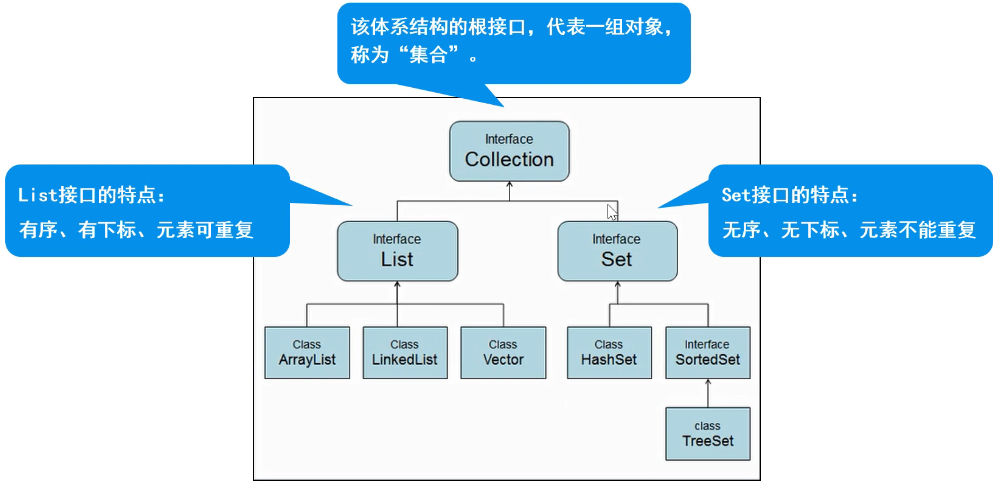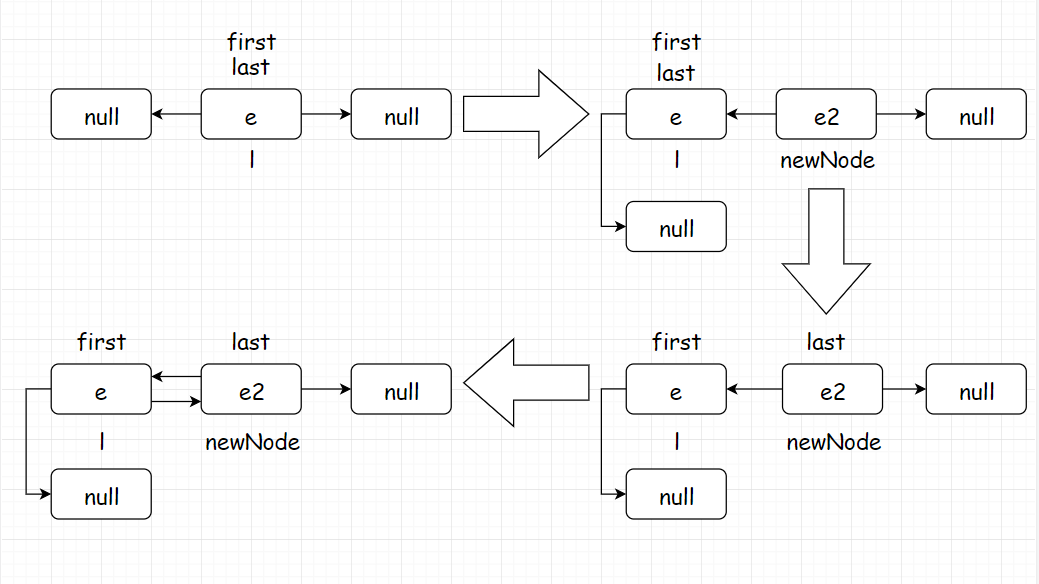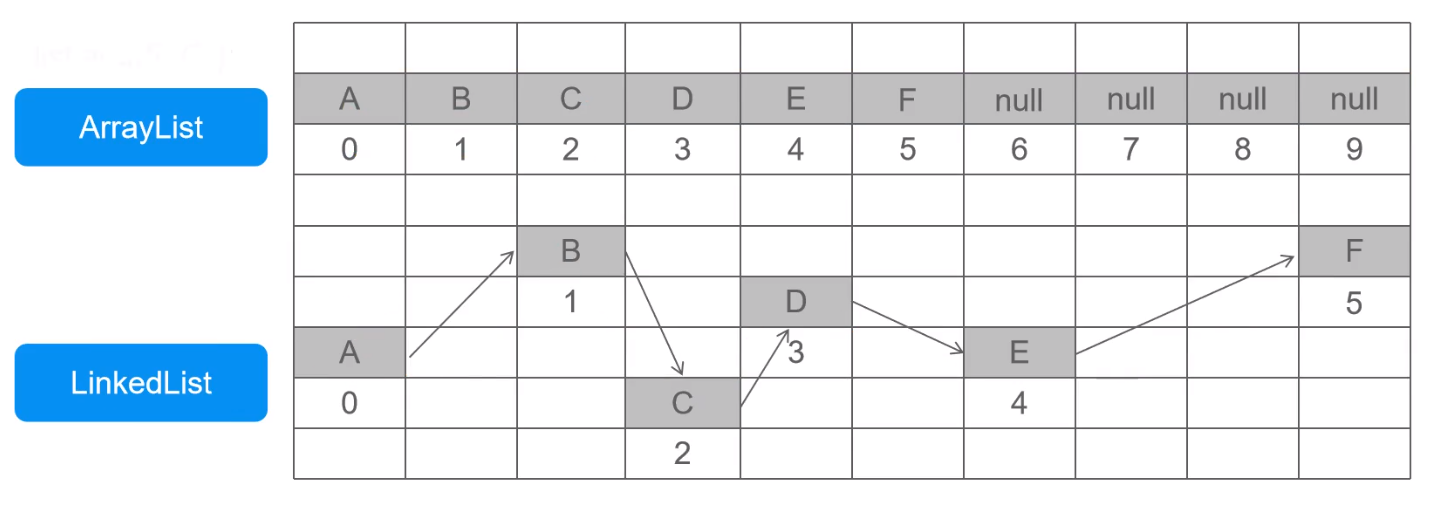本文主要是介绍java集合框架--千峰视频,希望对大家解决编程问题提供一定的参考价值,需要的开发者们随着小编来一起学习吧!
· JAVA集合框架详解
1、集合概述
- 概念:对象的容器,定义了对多个对象进项操作的的常用方法。可实现数组的功能。
- 和数组的区别:
- 数组长度固定,集合长度不固定。
- 数组可以存储基本类型和引用类型,集合只能存储引用类型。
- 位置: java.util.*;
2、Collection体系集合

Collection父接口
-
特点:代表一组任意类型的对象,无序、无下标、不能重复。
-
方法:
boolean add(Object obj) //添加一个对象。boolean addAll(Collection c) //将一个集合中的所有对象添加到此集合中。void clear() //清空此集合中的所有对象。boolean contains(Object o) //检查此集合中是否包含o对象。boolean equals(Object o) //比较此集合是否与指定对象相等。boolean isEmpty() //判断此集合是否为空。boolean remove(Object o) //在此集合中移除o对象。int size() //返回此集合中的元素个数。Object[] toArray() //将此集合转换成数组。
/*** Collection接口的使用(一)* 1.添加元素* 2.删除元素* 3.遍历元素* 4.判断*/
public class Collection01 {public static void main(String[] args){//创建集合Collection collection=new ArrayList();
// * 1.添加元素collection.add("苹果");collection.add("西瓜");collection.add("榴莲");System.out.println("元素个数:"+collection.size());System.out.println(collection);
// * 2.删除元素collection.remove("榴莲");System.out.println("删除之后:"+collection.size());
// * 3.遍历元素//3.1 使用增强forfor(Object object : collection){System.out.println(object);}//3.2 使用迭代器(迭代器专门用来遍历集合的一种方式)//hasNext();判断是否有下一个元素//next();获取下一个元素//remove();删除当前元素Iterator iterator = collection.iterator();while(iterator.hasNext()) {String object = (String) iterator.next();//里面存的是字符串西瓜、苹果...可以强转为stringSystem.out.println(object);}//删除操作//collection.remove(s);引发错误:并发修改异常//iterator.remove();应使用迭代器的方法
// * 4.判断System.out.println(collection.contains("西瓜"));//trueSystem.out.println(collection.isEmpty());//false}
}
/*** Collection接口的使用(二)* 1.添加元素* 2.删除元素* 3.遍历元素* 4.判断*/public class Demo2 {public static void main(String[] args) {Collection collection=new ArrayList();Student s1=new Student("张三",18);Student s2=new Student("李四", 20);Student s3=new Student("王五", 19);//1.添加数据collection.add(s1);collection.add(s2);collection.add(s3);//collection.add(s3);可重复添加相同对象System.out.println("元素个数:"+collection.size());System.out.println(collection.toString());//2.删除数据collection.remove(s1);System.out.println("删除之后:"+collection.size());//3.遍历数据//3.1 增强forfor(Object object:collection) {System.out.println(object.toString());}//3.2迭代器//迭代过程中不能使用collection的删除方法Iterator iterator=collection.iterator();while (iterator.hasNext()) {Student student=(Student) iterator.next();System.out.println(student.toString());}//4.判断和上一块代码类似。}}
/*** 学生类*/public class Student {private String name;private int age;public Student(String name, int age) {super();this.name = name;this.age = age;}public String getName() {return name;}public void setName(String name) {this.name = name;}public int getAge() {return age;}public void setAge(int age) {this.age = age;}@Overridepublic String toString() {return "Student [name=" + name + ", age=" + age +"]";}}
Collection子接口
List集合
-
特点:有序、有下标、元素可以重复。
-
方法:
void add(int index,Object o) //在index位置插入对象o。boolean addAll(index,Collection c) //将一个集合中的元素添加到此集合中的index位置。Object get(int index) //返回集合中指定位置的元素。List subList(int fromIndex,int toIndex) //返回fromIndex和toIndex之间的集合元素。
/**
-
List子接口的使用(一)
-
特点:1.有序有下标 2.可以重复
-
操作:
-
1.添加元素
-
2.删除元素
-
3.遍历元素
-
4.判断
-
5.获取位置
*/
public class List01 {public static void main(String[] args) {
List list=new ArrayList<>();
//1.添加元素
list.add(“tang”);
list.add(“he”);
list.add(0,“yu”);//插入操作
System.out.println(“元素个数:”+list.size());
System.out.println(list.toString());
//2.删除元素
list.remove(0);
//list.remove(“yu”);结果同上
System.out.println(“删除之后:”+list.size());
System.out.println(list.toString());
//3.遍历元素
//3.1 使用for遍历
for(int i=0;i<list.size();++i) {
System.out.println(list.get(i));//返回集合中指定位置的元素
}
//3.2 使用增强for
for(Object object:list) {
System.out.println(object);
}
//3.3 使用迭代器
Iterator iterator=list.iterator();
while (iterator.hasNext()) {
System.out.println(iterator.next());
}
//3.4使用列表迭代器,listIterator可以双向遍历,添加、删除及修改元素。
ListIterator listIterator=list.listIterator();
//从前往后
while (listIterator.hasNext()) {
System.out.println(listIterator.next());
}
//从后往前(此时“遍历指针”已经指向末尾)
while(listIterator.hasPrevious()) {
System.out.println(listIterator.previous());
}
//4.判断
System.out.println(list.isEmpty());
System.out.println(list.contains(“tang”));
//5.获取位置
System.out.println(list.indexOf(“tang”));
}
}
```Java/*** List子接口的使用(二)* 1.添加元素* 2.删除元素* 3.遍历元素* 4.判断* 5.获取位置* 6.subList方法*/public class List02 {public static void main(String[] args) {List list=new ArrayList();//1.添加数字数据(自动装箱)list.add(20);list.add(30);list.add(40);list.add(50);System.out.println("元素个数:"+list.size());System.out.println(list.toString());//2.删除元素//法一:删除索引list.remove(0);//list.remove(20);很明显数组越界错误,改成如下//法二:强转为object,删除元素//list.remove((Object)20);//法三:转为integer,删除元素//list.remove(new Integer(20 ));System.out.println("元素个数:"+list.size());System.out.println(list.toString());//3-5不再演示,与之前类似//6.补充方法subList,返回子集合,含头不含尾List list2=list.subList(1, 3);System.out.println(list2.toString());}}
List实现类
ArrayList【重点】
-
数组结构实现,查询块、增删慢;
-
JDK1.2版本,运行效率快、线程不安全。
/**
- ArrayList的使用
- 存储结构:数组;
- 特点:查找遍历速度快,增删慢。
- 1.添加元素
- 2.删除元素
- 3.遍历元素
- 4.判断
- 5.查找
*/
public class ArrayList01 {
public static void main(String[] args) {
ArrayList arrayList=new ArrayList<>();
//1.添加元素
Student s1=new Student(“唐”, 21);
Student s2=new Student(“何”, 22);
Student s3=new Student(“余”, 21);
arrayList.add(s1);
arrayList.add(s2);
arrayList.add(s3);
System.out.println(“元素个数:”+arrayList.size());
System.out.println(arrayList.toString());
//2.删除元素
arrayList.remove(s1);
//arrayList.remove(new Student(“唐”, 21));
//注:这样可以删除吗(不可以)?显然这是两个不同的对象。
//假如两个对象属性相同便认为其是同一对象,那么如何修改代码?重写equals方法
//3.遍历元素
//3.1使用迭代器
Iterator iterator=arrayList.iterator();
while(iterator.hasNext()) {
System.out.println(iterator.next());
}
//3.2使用列表迭代器
ListIterator listIterator=arrayList.listIterator();
//从前往后遍历
while(listIterator.hasNext()) {
System.out.println(listIterator.next());
}
//从后往前遍历
while(listIterator.hasPrevious()) {
System.out.println(listIterator.previous());
}
//4.判断
System.out.println(arrayList.isEmpty());
System.out.println(arrayList.contains(new Student(“何”, 22)));
//注:与上文相同的问题。
//5.查找
System.out.println(arrayList.indexOf(s3));
}
}
**注**:Object里的equals(this==obj)用地址和当前对象比较,如果想实现代码中的问题,可以在学生类中重写equals方法:```java
@Override
public boolean equals(Object obj) {//1.是否为同一对象if (this==obj) {return true;}//2.判断是否为空if (obj==null) {return false;}//3.判断是否是Student类型if (obj instanceof Student) {Student student=(Student) obj;//4.比较属性if(this.name.equals(student.getName())&&this.age==student.age) {return true;}}//不满足,返回falsereturn false;
}
ArrayList源码分析
-
默认容量大小:
private static final int DEFAULT_CAPACITY = 10; -
存放元素的数组:
transient Object[] elementData; -
实际元素个数:
private int size; -
创建对象时调用的无参构造函数:
//这是一个空的数组private static final Object[] DEFAULTCAPACITY_EMPTY_ELEMENTDATA = {};public ArrayList() {this.elementData = DEFAULTCAPACITY_EMPTY_ELEMENTDATA;} 这段源码说明当你没有向集合中添加任何元素时,集合容量为0。那么默认的10个容量怎么来的呢?
这就得看看add方法的源码了:
public boolean add(E e) {ensureCapacityInternal(size + 1); // Increments modCount!!elementData[size++] = e;return true;
}假设你new了一个数组,当前容量为0,size当然也为0。这时调用add方法进入到ensureCapacityInternal(size + 1);该方法源码如下:
private void ensureCapacityInternal(int minCapacity) {ensureExplicitCapacity(calculateCapacity(elementData, minCapacity));
} 该方法中的参数minCapacity传入的值为size+1也就是 1,接着我们再进入到calculateCapacity(elementData, minCapacity)里面:
private static int calculateCapacity(Object[] elementData, int minCapacity) {if (elementData == DEFAULTCAPACITY_EMPTY_ELEMENTDATA) {return Math.max(DEFAULT_CAPACITY, minCapacity);}return minCapacity;
}上文说过,elementData就是存放元素的数组,当前容量为0,if条件成立,返回默认容量`DEFAULT_CAPACITY`也就是10。这个值作为参数又传入`ensureExplicitCapacity()`方法中,进入该方法查看源码:
private void ensureExplicitCapacity(int minCapacity) {modCount++;// overflow-conscious codeif (minCapacity - elementData.length > 0)grow(minCapacity);
}我们先不要管modCount这个变量。
因为elementData数组长度为0,所以if条件成立,调用grow方法,重要的部分来了,我们再次进入到grow方法的源码中:
private void grow(int minCapacity) {// overflow-conscious codeint oldCapacity = elementData.length;int newCapacity = oldCapacity + (oldCapacity >> 1);if (newCapacity - minCapacity < 0)newCapacity = minCapacity;if (newCapacity - MAX_ARRAY_SIZE > 0)newCapacity = hugeCapacity(minCapacity);// minCapacity is usually close to size, so this is a win:elementData = Arrays.copyOf(elementData, newCapacity);
}这个方法先声明了一个oldCapacity变量将数组长度赋给它,其值为0;又声明了一个newCapacity变量其值为oldCapacity+一个增量,可以发现这个增量是和原数组长度有关的量,当然在这里也为0。第一个if条件满足,newCapacity的值为10(这就是默认的容量,不理解的话再看看前面)。第二个if条件不成立,也可以不用注意,因为MAX_ARRAY_SIZE的定义如下:
COPYprivate static final int MAX_ARRAY_SIZE = Integer.MAX_VALUE - 8;这个值太大了以至于第二个if条件没有了解的必要。
最后一句话就是为elementData数组赋予了新的长度,Arrays.copyOf()方法返回的数组是新的数组对象,原数组对象不会改变,该拷贝不会影响原来的数组。copyOf()的第二个自变量指定要建立的新数组长度,如果新数组的长度超过原数组的长度,则保留数组默认值。
这时候再回到add的方法中,接着就向下执行elementData[size++] = e;到这里为止关于ArrayList就讲解得差不多了,当数组长度为10的时候你们可以试着过一下源码,查一下每次的增量是多少(答案是每次扩容为原来的1.5倍)。
Vector
-
数组结构实现,查询快、增删慢;
-
JDK1.0版本,运行效率慢、线程安全。
/*** Vector的演示使用*1.添加数据*2.删除数据*3.遍历*4.判断*/public class Demo1 {public static void main(String[] args) {Vector vector=new Vector<>();//1.添加数据vector.add("tang");vector.add("he");vector.add("yu");System.out.println("元素个数:"+vector.size());//2.删除数据/** vector.remove(0); vector.remove("tang");*///3.遍历//使用枚举器Enumeration enumeration=vector.elements();while (enumeration.hasMoreElements()) {String s = (String) enumeration.nextElement();System.out.println(s);}//4.判断System.out.println(vector.isEmpty());System.out.println(vector.contains("he"));//5. Vector其他方法//firstElement() lastElement() ElementAt();}}
LinkedList
-
链表结构实现,增删快,查询慢。
/**
- LinkedList的用法
- 存储结构:双向链表
- 1.添加元素
- 2.删除元素
- 3.遍历
- 4.判断
*/
public class LinkedList01 {
public static void main(String[] args) {
LinkedList linkedList=new LinkedList<>();
Student s1=new Student(“唐”, 21);
Student s2=new Student(“何”, 22);
Student s3=new Student(“余”, 21);
//1.添加元素
linkedList.add(s1);
linkedList.add(s2);
linkedList.add(s3);
linkedList.add(s3);
System.out.println(“元素个数:”+linkedList.size());
System.out.println(linkedList.toString());
//2.删除元素
linkedList.remove(new Student(“唐”, 21));
System.out.println(linkedList.toString());
//3.遍历
//3.1 使用for
for(int i=0;i<linkedList.size();++i) {
System.out.println(linkedList.get(i));
}
//3.2 使用增强for
for(Object object:linkedList) {
Student student=(Student) object;
System.out.println(student.toString());
}
//3.3 使用迭代器
Iterator iterator =linkedList.iterator();
while (iterator.hasNext()) {
Student student = (Student) iterator.next();
System.out.println(student.toString());
}
//3.4 使用列表迭代器(略)
//4. 判断
System.out.println(linkedList.contains(s1));
System.out.println(linkedList.isEmpty());
System.out.println(linkedList.indexOf(s3));
}
}
* ##### **LinkedList源码分析**LinkedList首先有三个属性:- 链表大小:`transient int size = 0;`- (指向)第一个结点/头结点:` transient Node<E> first;`- (指向)最后一个结点/尾结点:`transient Node<E> last;`关于Node类型我们再进入到类里看看:
```javaprivate static class Node<E> {E item;Node<E> next;Node<E> prev;Node(Node<E> prev, E element, Node<E> next) {this.item = element;this.next = next;this.prev = prev;}
}首先item存放的是实际数据;next指向下一个结点而prev指向上一个结点。
Node带参构造方法的三个参数分别是前一个结点、存储的数据、后一个结点,调用这个构造方法时将它们赋值给当前对象。
LinkedList是如何添加元素的呢?先看看add方法:
COPYpublic boolean add(E e) {linkLast(e);return true;
}进入到linkLast方法:
COPYvoid linkLast(E e) {final Node<E> l = last;final Node<E> newNode = new Node<>(l, e, null);last = newNode;if (l == null)first = newNode;elsel.next = newNode;size++;modCount++;
}假设刚开始new了一个LinkedList对象,first和last属性都为空,调用add进入到linkLast方法。
首先创建一个Node变量 l 将last(此时为空)赋给它,然后new一个newNode变量存储数据,并且它的前驱指向l,后继指向null;再把last指向newNode。如下图所示:
[外链图片转存失败,源站可能有防盗链机制,建议将图片保存下来直接上传(img-qgVx5WPY-1658136972299)(https://pic.downk.cc/item/5f9a62a01cd1bbb86bc58487.png)]
如果满足if条件,说明这是添加的第一个结点,将first指向newNode:
[外链图片转存失败,源站可能有防盗链机制,建议将图片保存下来直接上传(img-9m0LG3Rj-1658136972300)(https://pic.downk.cc/item/5f9a631c1cd1bbb86bc59ca6.png)]
至此,LinkedList对象的第一个数据添加完毕。假设需要再添加一个数据,我们可以再来走一遍,过程同上不再赘述,图示如下:

ArrayList和LinkedList区别
- ArrayList:必须开辟连续空间,查询快,增删慢。
- LinkedList:无需开辟连续空间,查询慢,增删快。

泛型概述
- Java泛型是JDK1.5中引入的一个新特性,其本质是参数化类型,把类型作为参数传递。
- 常见形式有泛型类、泛型接口、泛型方法。
- 语法:
- <T,…> T称为类型占位符,表示一种引用类型。
- 好处:
- 提高代码的重用性。
- 防止类型转换异常,提高代码的安全性。
泛型类
/*** 泛型类* 语法:类名<T>* T是类型占位符,表示一种引用类型,编写多个使用逗号隔开* */public class myGeneric<T>{//1.创建泛型变量//不能使用new来创建,因为泛型是不确定的类型,也可能拥有私密的构造方法。T t;//2.泛型作为方法的参数public void show(T t) {System.out.println(t);}//泛型作为方法的返回值public T getT() {return t;}}/*** 注意:* 1.泛型只能使用引用类型* 2.不同泛型类型的对象不能相互赋值*/
public class testGeneric {public static void main(String[] args) {//使用泛型类创建对象myGeneric<String> myGeneric1=new myGeneric<String>();myGeneric1.t="tang";myGeneric1.show("he");myGeneric<Integer> myGeneric2=new myGeneric<Integer>();myGeneric2.t=10;myGeneric2.show(20);Integer integer=myGeneric2.getT();}
}
泛型接口
/*** 泛型接口* 语法:接口名<T>* 注意:不能创建泛型静态常量*/
public interface myInterface<T> {//创建常量String nameString="tang";//创建方法T server(T t);
}
/*** 实现接口时确定泛型类*/
public class myInterfaceImpl implements myInterface<String> {@Overridepublic String server(String t) {System.out.println(t);return t;}
}
//测试myInterfaceImpl myInterface = new myInterfaceImpl();myInterface.server("zhang");//zhang
/*** 实现接口时不确定泛型类*/
public class MyInterfaceImpl2<T> implements MyInterface<T>{@Overridepublic T server(T t) {System.out.println(t);return t;}
}
//测试myInterfaceImpl2<Integer> inter2=new myInterfaceImpl2<Integer>();inter2.server(2000);
//2000
泛型方法
/*** 泛型方法* 语法:<T> 返回类型*/
public class MyGenericMethod {public <T> void show(T t) {System.out.println("泛型方法"+t);}
}//测试
MyGenericMethod myGenericMethod=new MyGenericMethod();
myGenericMethod.show("tang");
myGenericMethod.show(200);
myGenericMethod.show(3.14);
泛型集合
-
概念:参数化类型、类型安全的集合,强制集合元素的类型必须一致。
-
特点
- 编译时即可检查,而非运行时抛出异常。
-
访问时,不必类型转换(拆箱)。
- 不同泛型指尖引用不能相互赋值,泛型不存在多态。
之前我们在创建LinkedList类型对象的时候并没有使用泛型,但是进到它的源码中会发现:
COPYpublic class LinkedList<E>extends AbstractSequentialList<E>implements List<E>, Deque<E>, Cloneable, java.io.Serializable{//略}它是一个泛型类,而我之前使用的时候并没有传递,说明java语法是允许的,这个时候传递的类型是Object类,虽然它是所有类的父类,可以存储任意的类型,但是在遍历、获取元素时需要原来的类型就要进行强制转换。这个时候就会出现一些问题,假如往链表里存储了许多不同类型的数据,在强转的时候就要判断每一个原来的类型,这样就很容易出现错误。
Set集合概述
Set子接口
- 特点:无序、无下标、元素不可重复。
- 方法:全部继承自Collection中的方法。
/*** 测试Set接口的使用* 特点:1.无序,没有下标;2.不可重复* 1.添加数据* 2.删除数据* 3.遍历【重点】* 4.判断*/
public class Set01 {public static void main(String[] args) {Set<String> set=new HashSet<String>();//1.添加数据set.add("tang");set.add("he");set.add("yu");System.out.println("数据个数:"+set.size());System.out.println(set.toString());//无序输出//2.删除数据set.remove("tang");System.out.println(set.toString());//3.遍历【重点】//3.1 使用增强forfor (String string : set) {System.out.println(string.toString());}//3.2 使用迭代器Iterator<String> iterator=set.iterator();while (iterator.hasNext()) {System.out.println(iterator.next());}//4.判断System.out.println(set.contains("tang"));System.out.println(set.isEmpty());}}Set实现类
HashSet【重点】
- 基于HashCode计算元素存放位置。
- 当存入元素的哈希码相同时,会调用equals进行确认,如结果为true,则拒绝后者存入。
public class Person {private String name;private int age;public Person(String name,int age) {this.name = name;this.age = age;}public String getName() {return name;}public void setName(String name) {this.name = name;}public int getAge() {return age;}public void setAge(int age) {this.age = age;}@Overridepublic String toString() {return "Peerson [name=" + name + ", age=" + age + "]";}}/*** HashSet集合的使用* 存储结构:哈希表(数组+链表+红黑树)* 1.添加元素* 2.删除元素* 3.遍历* 4.判断*/
public class HashSet01 {public static void main(String[] args) {HashSet<Person> hashSet=new HashSet<>();Person p1=new Person("tang",21);Person p2=new Person("he", 22);Person p3=new Person("yu", 21);//1.添加元素hashSet.add(p1);hashSet.add(p2);hashSet.add(p3);//重复,添加失败hashSet.add(p3);//直接new一个相同属性的对象,依然会被添加,不难理解。//假如相同属性便认为是同一个对象,怎么修改?hashSet.add(new Person("yu", 21));System.out.println(hashSet.toString());//2.删除元素hashSet.remove(p2);//3.遍历//3.1 增强forfor (Person person : hashSet) {System.out.println(person);}//3.2 迭代器Iterator<Person> iterator=hashSet.iterator();while (iterator.hasNext()) {System.out.println(iterator.next());}//4.判断System.out.println(hashSet.isEmpty());//直接new一个相同属性的对象结果输出是false,不难理解。//注:假如相同属性便认为是同一个对象,该怎么做?System.out.println(hashSet.contains(new Person("tang", 21)));}}
注:HashSet存储过程:
- 根据hashCode计算保存的位置,如果位置为空,则直接保存,否则执行第二步。
- 执行equals方法,如果方法返回true,则认为是重复,拒绝存储,否则形成链表。
存储过程实际上就是重复依据,要实现“注”里的问题,可以重写hashCode和equals代码:
@Override
public int hashCode() {final int prime = 31;int result = 1;result = prime * result + age;result = prime * result + ((name == null) ? 0 : name.hashCode());return result;
}
@Override
public boolean equals(Object obj) {if (this == obj)return true;if (obj == null)return false;if (getClass() != obj.getClass())return false;Person other = (Person) obj;if (age != other.age)return false;if (name == null) {if (other.name != null)return false;} else if (!name.equals(other.name))return false;return true;
}hashCode方法里为什么要使用31这个数字大概有两个原因:
- 31是一个质数,这样的数字在计算时可以尽量减少散列冲突。
- 可以提高执行效率,因为31*i=(i<<5)-i,31乘以一个数可以转换成移位操作,这样能快一点;
TreeSet
- 基于排序顺序实现不重复。
- 实现了SortedSet接口,对集合元素自动排序。
- 元素对象的类型必须实现Comparable接口,指定排序规则。
- 通过CompareTo方法确定是否为重复元素。
/*** 使用TreeSet保存数据* 存储结构:红黑树 类似平衡二叉树,左小右大,只不过差值可以大于1* 要求:元素类必须实现Comparable接口,compareTo方法返回0,认为是重复元素*/
public class TreeSet01 {public static void main(String[] args) {TreeSet<Person> persons=new TreeSet<Person>();Person p1=new Person("tang",21);Person p2=new Person("he", 22);Person p3=new Person("yu", 21);//1.添加元素persons.add(p1);persons.add(p2);persons.add(p3);//注:直接添加会报类型转换错误,需要实现Comparable接口System.out.println(persons.toString());//2.删除元素persons.remove(p1);persons.remove(new Person("he", 22));System.out.println(persons.toString());//3.遍历(略)//4.判断System.out.println(persons.contains(new Person("yu", 21)));}
}
查看Comparable接口的源码,发现只有一个compareTo抽象方法,在人类中实现它:
public class Person implements Comparable<Person>{@Override//按顺序输出//1.先按姓名比//2.再按年龄比public int compareTo(Person o) {int n1=this.getName().compareTo(o.getName());int n2=this.age-o.getAge();return n1==0?n2:n1;}
}除了实现Comparable接口里的比较方法,TreeSet也提供了一个带比较器Comparator的构造方法,使用匿名内部类来实现它:
/*** TreeSet的使用,不用接口,用Comparator匿名内部类实现* Comparator:实现定制比较(比较器)*/
public class TreeSet02 {public static void main(String[] args) {TreeSet<Person> persons=new TreeSet<Person>(new Comparator<Person>() {@Overridepublic int compare(Person o1, Person o2) {// 先按年龄比较// 再按姓名比较int n1=o1.getAge()-o2.getAge();int n2=o1.getName().compareTo(o2.getName());return n1==0?n2:n1;}});Person p1=new Person("tang",21);Person p2=new Person("he", 22);Person p3=new Person("yu", 21);persons.add(p1);persons.add(p2);persons.add(p3);System.out.println(persons.toString());}
}
接下来我们来做一个小案例:
/*** 要求:使用TreeSet集合实现字符串按照长度进行排序* helloworld tangrui hechengyang wangzixu yuguoming* Comparator接口实现定制比较*/
public class TreeSetCase {public static void main(String[] args) {TreeSet<String> treeSet=new TreeSet<String>(new Comparator<String>() {@Override//先比较字符串长度//再比较字符串public int compare(String o1, String o2) {int n1=o1.length()-o2.length();int n2=o1.compareTo(o2);return n1==0?n2:n1;}});treeSet.add("helloworld");treeSet.add("tangrui");treeSet.add("hechenyang");treeSet.add("yuguoming");treeSet.add("wangzixu");System.out.println(treeSet.toString());//输出[tangrui, wangzixu, yuguoming, hechenyang, helloworld]}
}3、Map体系集合
-
Map接口的特点:
- 用于存储任意键值对(Key-Value)。
- 键:无序、无下标、不允许重复(唯一)。
- 值:无序、无下标、允许重复。
Map集合概述
-
特点:存储一对数据(Key-Value),无序、无下标,键不可重复。
-
方法:
V put(K key,V value)//将对象存入到集合中,关联键值。key重复则覆盖原值。
-
Object get(Object key)//根据键获取相应的值。Set<K>//返回所有的keyCollection<V> values()//返回包含所有值的Collection集合。Set<Map.Entry<K,V>>//键值匹配的set集合
/*** Map接口的使用* 特点:1.存储键值对 2.键不能重复,值可以重复 3.无序*/
public class Map01 {public static void main(String[] args) {Map<String,Integer> map=new HashMap<>();//1.添加元素map.put("tang", 21);map.put("he", 22);map.put("fan", 23);//添加相同的key,不会新增value会被覆盖,添加相同的value会新增//map.put("fan",80);System.out.println(map.toString());//2.删除元素map.remove("he");System.out.println(map.toString());//3.遍历//3.1 使用keySet();先遍历key,在根据key调用get方法获取valuefor (String key : map.keySet()) {System.out.println(key+"---"+map.get(key));//map.get(key) 通过key获取value}//3.2 使用entrySet();效率较高for (Map.Entry<String, Integer> entry : map.entrySet()) {System.out.println(entry.getKey()+" "+entry.getValue());//System.out.println(entry);//entrySet()先储存键值对,在遍历键值对}//判断System.out.println(map.containsKey("tang"));System.out.println(map.containsValue("22"));}
}Map集合的实现类
HashMap【重点】
-
JDK1.2版本,线程不安全,运行效率快;允许用null作为key或是value。
/*** 学生类*/public class Student {private String name;private int id; public Student(String name, int id) {super();this.name = name;this.id = id;}public String getName() {return name;}public void setName(String name) {this.name = name;}public int getId() {return id;}public void setId(int id) {this.id = id;}@Overridepublic String toString() {return "Student [name=" + name + ", age=" + id + "]";}}/*** HashMap的使用* 存储结构:哈希表(数组+链表+红黑树)*/public class Demo2 {public static void main(String[] args) {HashMap<Student, String> hashMap=new HashMap<Student, String>();Student s1=new Student("tang", 36);Student s2=new Student("yu", 101);Student s3=new Student("he", 10);//1.添加元素hashMap.put(s1, "成都");hashMap.put(s2, "杭州");hashMap.put(s3, "郑州");//添加失败,但会更新值hashMap.put(s3,"上海");//添加成功,不过两个属性一模一样;//注:假如相同属性便认为是同一个对象,怎么修改?hashMap.put(new Student("he", 10),"上海");System.out.println(hashMap.toString());//2.删除元素hashMap.remove(s3);System.out.println(hashMap.toString());//3.遍历//3.1 使用keySet()遍历for (Student key : hashMap.keySet()) {System.out.println(key+" "+hashMap.get(key));}//3.2 使用entrySet()遍历for (Entry<Student, String> entry : hashMap.entrySet()) {System.out.println(entry.getKey()+" "+entry.getValue());}//4.判断//注:同上System.out.println(hashMap.containsKey(new Student("he", 10)));System.out.println(hashMap.containsValue("成都"));}}注:和之前说过的HashSet类似,重复依据是hashCode和equals方法,重写即可:
COPY@Overridepublic int hashCode() {final int prime = 31;int result = 1;result = prime * result + id;result = prime * result + ((name == null) ? 0 : name.hashCode());return result;}@Overridepublic boolean equals(Object obj) {if (this == obj)return true;if (obj == null)return false;if (getClass() != obj.getClass())return false;Student other = (Student) obj;if (id != other.id)return false;if (name == null) {if (other.name != null)return false;} else if (!name.equals(other.name))return false;return true;}HashMap源码分析
-
默认初始化容量:
static final int DEFAULT_INITIAL_CAPACITY = 1 << 4; // aka 16- 数组最大容量:
static final int MAXIMUM_CAPACITY = 1 << 30;
- 数组最大容量:
-
默认加载因子:
static final float DEFAULT_LOAD_FACTOR = 0.75f; -
链表调整为红黑树的链表长度阈值(JDK1.8):
static final int TREEIFY_THRESHOLD = 8; -
红黑树调整为链表的链表长度阈值(JDK1.8):
static final int UNTREEIFY_THRESHOLD = 6; -
链表调整为红黑树的数组最小阈值(JDK1.8):
static final int MIN_TREEIFY_CAPACITY = 64; -
HashMap存储的数组:
transient Node<K,V>[] table; -
HashMap存储的元素个数:
transient int size;- 默认加载因子是什么?
- 就是判断数组是否扩容的一个因子。假如数组容量为100,如果HashMap的存储元素个数超过了100*0.75=75,那么就会进行扩容。
- 链表调整为红黑树的链表长度阈值是什么?
- 假设在数组中下标为3的位置已经存储了数据,当新增数据时通过哈希码得到的存储位置又是3,那么就会在该位置形成一个链表,当链表过长时就会转换成红黑树以提高执行效率,这个阈值就是链表转换成红黑树的最短链表长度;
- 红黑树调整为链表的链表长度阈值是什么?
- 当红黑树的元素个数小于该阈值时就会转换成链表。
- 链表调整为红黑树的数组最小阈值是什么?
- 并不是只要链表长度大于8就可以转换成红黑树,在前者条件成立的情况下,数组的容量必须大于等于64才会进行转换。
HashMap的数组table存储的就是一个个的Node<K,V>类型,很清晰地看到有一对键值,还有一个指向next的指针(以下只截取了部分源码):
static class Node<K,V> implements Map.Entry<K,V> {final K key;V value;Node<K,V> next;} - 默认加载因子是什么?
之前的代码中在new对象时调用的是HashMap的无参构造方法,进入到该构造方法的源码查看一下:
public HashMap() {this.loadFactor = DEFAULT_LOAD_FACTOR; // all other fields defaulted}发现没什么内容,只是赋值了一个默认加载因子;而在上文我们观察到源码中table和size都没有赋予初始值,说明刚创建的HashMap对象没有分配容量,并不拥有默认的16个空间大小,这样做的目的是为了节约空间,此时table为null,size为0。
当我们往对象里添加元素时调用put方法:
public V put(K key, V value) {return putVal(hash(key), key, value, false, true);}
put方法把key和value传给了putVal,同时还传入了一个hash(Key)所返回的值,这是一个产生哈希值的方法,再进入到putVal方法(部分源码):
final V putVal(int hash, K key, V value, boolean onlyIfAbsent,boolean evict) {Node<K,V>[] tab; Node<K,V> p; int n, i;if ((tab = table) == null || (n = tab.length) == 0)n = (tab = resize()).length;if ((p = tab[i = (n - 1) & hash]) == null)tab[i] = newNode(hash, key, value, null);else{//略}}
这里面创建了一个tab数组和一个Node变量p,第一个if实际是判断table是否为空,而我们现在只关注刚创建HashMap对象时的状态,此时tab和table都为空,满足条件,执行内部代码,这条代码其实就是把resize()所返回的结果赋给tab,n就是tab的长度,resize顾名思义就是重新调整大小。查看resize()源码(部分):
final Node<K,V>[] resize() {Node<K,V>[] oldTab = table;int oldCap = (oldTab == null) ? 0 : oldTab.length;int oldThr = threshold;if (oldCap > 0);else if (oldThr > 0);else { // zero initial threshold signifies using defaultsnewCap = DEFAULT_INITIAL_CAPACITY;newThr = (int)(DEFAULT_LOAD_FACTOR * DEFAULT_INITIAL_CAPACITY);} @SuppressWarnings({"rawtypes","unchecked"})Node<K,V>[] newTab = (Node<K,V>[])new Node[newCap];table = newTab;return newTab;}该方法首先把table及其长度赋值给oldTab和oldCap;threshold是阈值的意思,此时为0,所以前两个if先不管,最后else里newCap的值为默认初始化容量16;往下创建了一个newCap大小的数组并将其赋给了table,刚创建的HashMap对象就在这里获得了初始容量。然后我们再回到putVal方法,第二个if就是根据哈希码得到的tab中的一个位置是否为空,为空便直接添加元素,此时数组中无元素所以直接添加。至此HashMap对象就完成了第一个元素的添加。当添加的元素超过16*0.75=12时,就会进行扩容:
final V putVal(int hash, K key, V value, boolean onlyIfAbsent,boolean evict){if (++size > threshold)resize();}
扩容的代码如下(部分):
final Node<K,V>[] resize() {int oldCap = (oldTab == null) ? 0 : oldTab.length;int newCap;if (oldCap > 0) {if (oldCap >= MAXIMUM_CAPACITY) {//略}else if ((newCap = oldCap << 1) < MAXIMUM_CAPACITY &&oldCap >= DEFAULT_INITIAL_CAPACITY)}}核心部分是else if里的移位操作,也就是说每次扩容都是原来大小的两倍。
- 注*:额外说明的一点是在JDK1.8以前链表是头插入,JDK1.8以后链表是尾插入。
HashSet源码分析
了解完HashMap之后,再回过头来看之前的HashSet源码,为什么放在后面写你们看一下源码就知道了(部分):
public class HashSet<E>extends AbstractSet<E>implements Set<E>, Cloneable, java.io.Serializable
{private transient HashMap<E,Object> map;private static final Object PRESENT = new Object();public HashSet() {map = new HashMap<>();}
}
可以看见HashSet的存储结构就是HashMap,那它的存储方式是怎样的呢?可以看一下add方法:
public boolean add(E e) {return map.put(e, PRESENT)==null;}很明了地发现它的add方法调用的就是map的put方法,把元素作为map的key传进去的。。
Hashtable
-
JDK1.0版本,线程安全,运行效率慢;不允许null作为key或是value。
-
初始容量11,加载因子0.75。
这个集合在开发过程中已经不用了,稍微了解即可。
Properties
- Hashtable的子类,要求key和value都是String。通常用于配置文件的读取。
它继承了Hashtable的方法,与流关系密切,此处不详解。
TreeMap
- 实现了SortedMap接口(是Map的子接口),可以对key自动排序。
/*** TreeMap的使用* 存储结构:红黑树*/
public class TreeMap01 {public static void main(String[] args) {TreeMap<Student, Integer> treeMap = new TreeMap<Student,Integer>();Student s1=new Student("tang", 36);Student s2=new Student("yu", 101);Student s3=new Student("he", 10);//1.添加元素treeMap.put(s1, 21);treeMap.put(s2, 22);treeMap.put(s3, 21);//不能直接打印,需要实现Comparable接口,因为红黑树需要比较大小System.out.println(treeMap.toString());//2.删除元素treeMap.remove(new Student("he", 10));System.out.println(treeMap.toString());//3.遍历//3.1 使用keySet()for (Student key : treeMap.keySet()) {System.out.println(key+" "+treeMap.get(key));}//3.2 使用entrySet()for (Map.Entry<Student, Integer> entry : treeMap.entrySet()) {System.out.println(entry.getKey()+"--"+entry.getValue());}//4.判断System.out.println(treeMap.containsKey(s1));System.out.println(treeMap.isEmpty());}
}
在学生类中实现Comparable接口:
public class Student implements Comparable<Student>{@Overridepublic int compareTo(Student o) {int n1=this.id-o.id;return n1;
}除此之外还可以使用比较器来定制比较:
TreeMap<Student, Integer> treeMap2=new TreeMap<Student, Integer>(new Comparator<Student>() {@Overridepublic int compare(Student o1, Student o2) {int n1=o1.id-o2.id;return n1;}
});TreeSet源码
和HashSet类似,放在TreeMap之后讲便一目了然(部分):
public class TreeSet<E> extends AbstractSet<E>implements NavigableSet<E>, Cloneable, java.io.Serializable
{private transient NavigableMap<E,Object> m;private static final Object PRESENT = new Object();TreeSet(NavigableMap<E,Object> m) {this.m = m;}public TreeSet() {this(new TreeMap<E,Object>());}
}TreeSet的存储结构实际上就是TreeMap,再来看其存储方式:
COPYpublic boolean add(E e) {return m.put(e, PRESENT)==null;
}
它的add方法调用的就是TreeMap的put方法,将元素作为key传入到存储结构中。
4、Collections工具类
-
概念:集合工具类,定义了除了存取以外的集合常用方法。
-
方法:
-
public static void reverse(List<?> list)//反转集合中元素的顺序public static void shuffle(List<?> list)//随机重置集合元素的顺序public static void sort(List<T> list)//升序排序(元素类型必须实现Comparable接口)
/*** 演示Collections工具类的使用*/
public class ToolClass {public static void main(String[] args) {List<Integer> list=new ArrayList<Integer>();list.add(20);list.add(10);list.add(30);list.add(90);list.add(70);//sort排序System.out.println(list.toString());Collections.sort(list);System.out.println(list.toString());System.out.println("---------");//binarySearch二分查找int i=Collections.binarySearch(list, 70);//找到70的在集合中的位置,3System.out.println(i);//copy复制List<Integer> list2=new ArrayList<Integer>();//现在集合list2为空,需要先扩充数组for(int j=0;j< list.size();j++) {list2.add(j);}//该方法要求目标元素容量大于等于源目标Collections.copy(list2, list);System.out.println(list2.toString());//reserve反转Collections.reverse(list2);System.out.println(list2.toString());//shuffle 打乱Collections.shuffle(list2);System.out.println(list2.toString());//补充:list转成数组Integer[] arr=list.toArray(new Integer[0]);//数组的值大小[0]只要小于集合,则按照集合的大小,大于集合,则按照数组定于的大小System.out.println(arr.length);//补充:数组转成集合String[] nameStrings= {"tang","he","yu"};//受限集合,不能添加和删除List<String> list3= Arrays.asList(nameStrings);System.out.println(list3);//注:基本类型转成集合时需要修改为包装类Integer[] nums={1,2,3,4,659,756}; //注意定义数组用integer,不用intList<Integer> asList = Arrays.asList(nums);System.out.println(asList);}
}这篇关于java集合框架--千峰视频的文章就介绍到这儿,希望我们推荐的文章对编程师们有所帮助!






